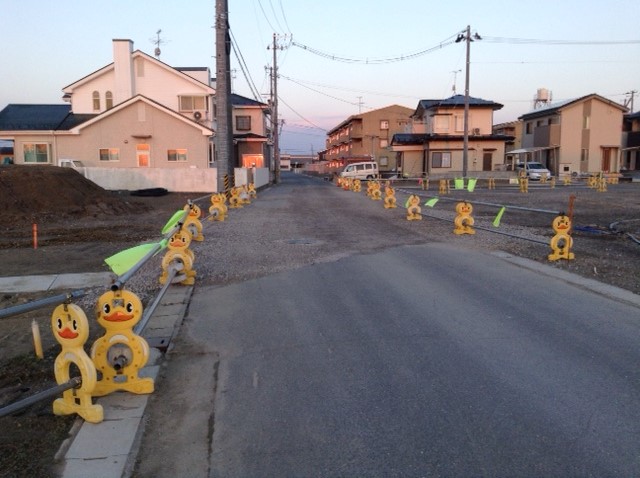
Construction in Ishinomaki, Miyagi Prefecture
3.11
Visiting Japan four years out from the magnitude 9.0 earthquake and thousand-year tsunami that hit the Tohoku region of Japan on March 11, 2011 (3.11), signs of new hope mingle with signs of continuing struggle. Compared to two or three years ago, however, the overall sense is that the future is finally beginning to take shape, even if the past still defines the landscape.
Even now it is sobering to see the extent of the damage wrought by 3.11. Due to Japan’s stringent building codes and hard lessons learned in the Hanshin Awaji Earthquake of 1995, damage from the initial earthquake, although it was the strongest quake ever recorded in Japan, was relatively limited and a response was mobilized fairly quickly. The massive tsunami, of course, was the first major element that made this situation different from any in previous modern history, and the Fukushima Nuclear Power Plant failure was the second. This triple nature of the events on 3.11 not only compounded the suffering of many areas; it also produced quite disparate situations depending on the location.
The three prefectures of Iwate, Miyagi, and Fukushima, working north to south, were hardest hit. However, considerable damage was also inflicted on areas beyond these three, such as in Chiba Prefecture, next to Tokyo. It is also important to note that a distinction must be drawn between the coastal and inland areas of each prefecture, and to remember that even when speaking about the “three Tohoku prefectures (Tohoku Sanken)” many areas show little sign of the events of four years ago.
Rebuilding along the coast
As the damage suffered by each community was different, so is the approach being taken to rebuilding. Rikuzentakata City, in Iwate Prefecture, is undertaking a massive project to raise the level of the entire Takata district of the city, which fronts the ocean, along with some other smaller areas. As with many communities down the coast, a buffer zone of levies, seawalls, and forested bands will run along the waterfront, with a first tier of land raised approximately nine meters, to be used for business and industrial activities, and a second raised approximately eleven meters, for residential development. Other areas, such as the Takekoma district, further inland, will not be raised as high, since this is another business / industrial area and people there have more ready access to high ground. The thinking is that the effort should be made to raise residential areas beyond even the thousand-year tsunami line, since there is no guarantee that a future disaster won’t happen at night, when people would have more difficulty fleeing, but that areas used in the daytime could be sacrificed in the worst case as long as people have the chance to escape to higher ground and return to their homes.
Much attention has been paid to complaints that the rebuilding is not going quickly enough, and this feeling is understandable when one thinks of all the people forced to live in temporary housing or to make difficult choices about whether to stick it out in the region until they can rebuild their lives or to move elsewhere in search of a new beginning. As recently reported in the Japan Times, only roughly 18 percent of the new permanent housing scheduled for completion by March 2018 had been built as of January 2015 in Iwate and Miyagi, and a mere 5 percent in Fukushima. Clearly, the number of temporary housing residents still waiting for permanent homes four years after the disasters compares very unfavorably with previous situations such as the Hanshin Awaji Earthquake that devastated the City of Kobe.
Much of the reason for this, though, is the decision to undertake the unprecedented civil engineering feat of raising the land under the affected communities before moving to rebuild them. In all other disasters, it was basically possible to clear away the rubble and proceed fairly rapidly to rebuilding. The fact that land along the coast in Tohoku subsided approximately one meter during the quake (although it has rebounded to some degree in the years since) combined with concerns about future tsunami compelled policy makers to require terracing (kasaage) on a scale heretofore unseen before reconstruction could begin. This is compounded, of course, in Fukushima, by the need to remediate certain areas that are too irradiated to allow residents to return at this time.
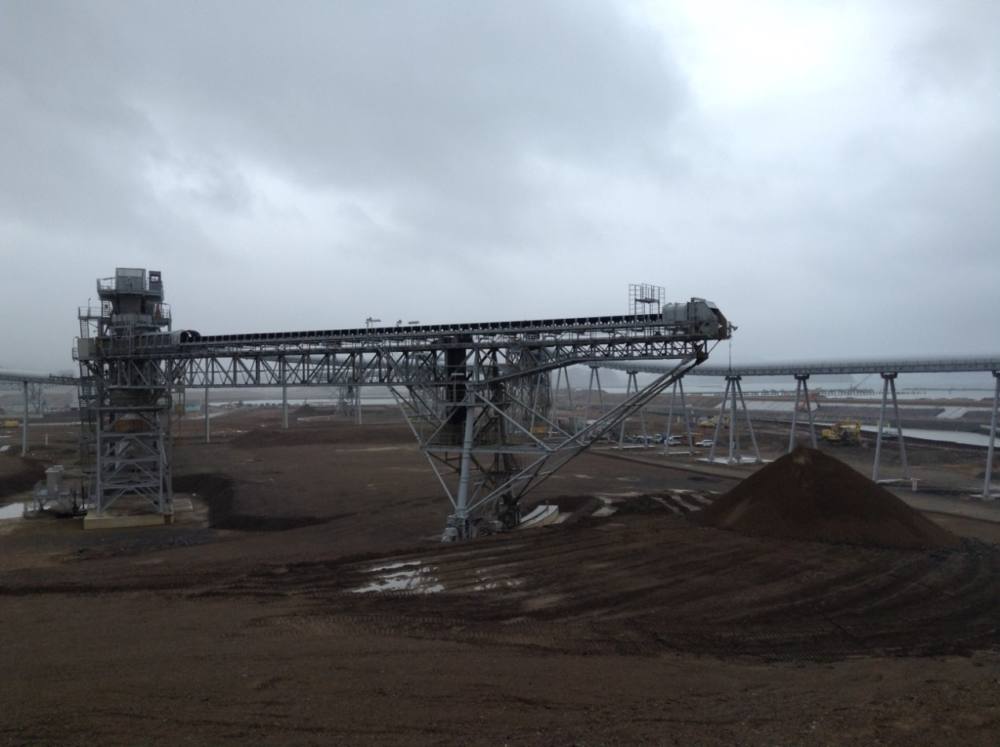
Part of Rikuzentakata’s conveyor belt system for moving earth from a neighboring mountain
In order to provide the approximately 6.4 million cubic meters of fill needed to raise the city of Rikuzentakata, they are shaving a neighboring mountain down from approximately 120 meters to 40 and moving the earth across the Kesen River and into the Takata district using a system of conveyor belts with a total length of three kilometers that is able to move up to 4,000 dump trucks worth of material every day. The mountain, once work is complete, will provide another new housing district on high ground. The entire terracing project will still take at least another four years to complete, although one permanent public housing development and a couple of hotels have been completed in the Takata district, and another block of apartments is scheduled to be finished soon. Some areas may be ready for new construction to begin by later this year.
A similar process, though using dump trucks rather than conveyors, is going on in most communities devastated by the tsunami, although on not quite the same scale. Altogether, some estimates place the total amount of fill needed in the three prefectures for various planned terracing and levee projects to be roughly 40 million cubic meters. This is enough earth to fill the 55,000 seat Tokyo Dome 32 times.
The community probably furthest along in this undertaking is Onagawa Town, in Miyagi Prefecture. The town just opened its new train station on March 21st, and has made substantial progress in laying out the civic plaza that will lead from the station down to the waterfront. Some new business facilities, such as a marine products processing plant, have already been built on the waterfront, and it is expected that new housing developments should also begin construction within about the next year. Smaller fishing villages outside Onagawa are also undergoing terracing, and housing construction may be able to start in some places by early this summer in areas where the mountains have been levelled. Areas where the land is being raised will probably start becoming available for construction by the middle of 2016.
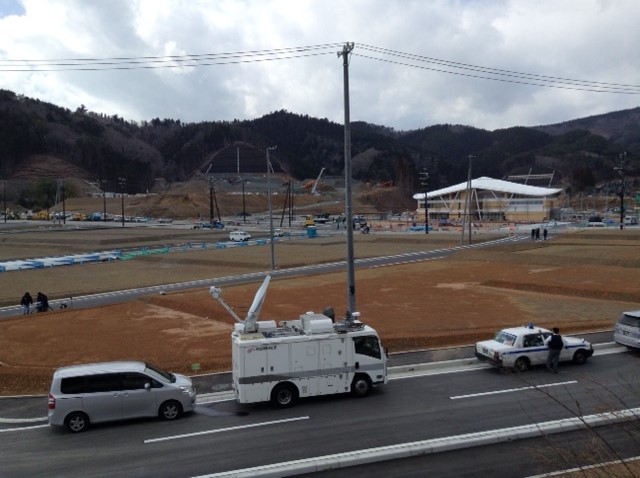 Onagawa’s new station and plaza
Onagawa’s new station and plaza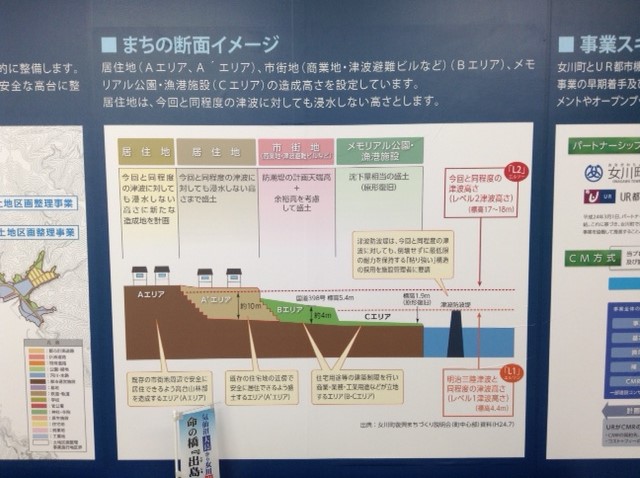
A cross-section view of the new landscape
Admittedly, Onagawa has benefitted from advantages not always enjoyed by other communities, including dynamic political leadership, strong community involvement, and money from the nuclear power plant located within the town’s jurisdiction. The smaller, more cohesive nature of the community is also an advantage that larger, recently amalgamated cities like Ishinomaki don’t enjoy.
Ishinomaki City, located next to Onagawa in Miyagi Prefecture, is pursuing a somewhat different approach to rebuilding as a more resilient city. The coastal areas of the city were destroyed when the tsunami drove through them and large areas of the rest of the city, though spared the brunt of the water’s force, were inundated to the depth of two to three meters, leaving behind extensive damage. Here, however, the strategy for rebuilding is to create a waterfront buffer using breakwaters, parkland, and levees topped by roads to deflect smaller waves and at least slow a major tsunami enough to allow residents time to escape to higher ground. The calculus appears to be to abandon areas like the Kadonowaki district on the coast in favor of moving residents to other parts of the city that are more defensible behind levees and which will have access to high ground or tsunami evacuation towers to which residents can flee. This appears to partly be driven by the fact that with relatively more buildings and infrastructure surviving the tsunami, it makes more sense to adopt less-invasive defensive measures than it does to destroy everything that remains in order to raise the ground level and rebuild.
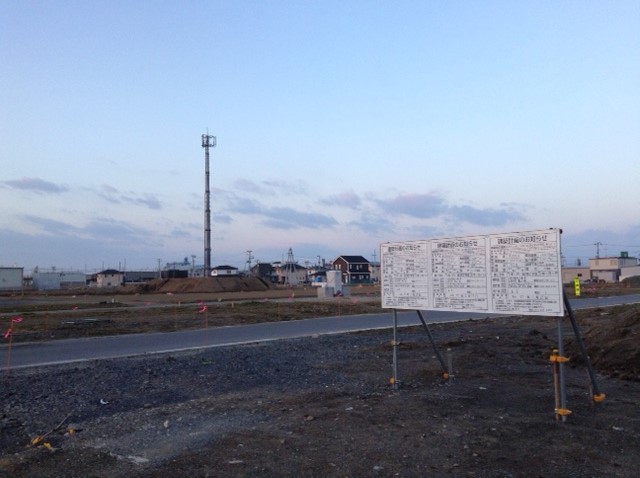
Tsukiyama District, Ishinomaki: Land for housing in the foreground will be raised slightly,and defended from the sea by a levee with a roadway to be built along the coast in the background.
Issues with rebuilding
Underlying all recovery efforts is the reality that is beginning to come more clearly into focus as the immediate effects of the disasters are dealt with: The issues that were facing the region prior to 3.11, foremost of which were limited opportunities for young people and an elderly and declining population, have only been exacerbated by the disasters, and the need to recover from the destruction wrought on the coast is ultimately inseparable from the need to somehow address these longstanding issues.
The first question arising out of these issues, concerning this terracing and rebuilding effort is, is it worth it to invest so heavily in communities along the coast when many of them were dying to begin with? This question was, admittedly, raised from the beginning, and only grows as a conundrum as resources are poured into the terracing effort while more and more people decide to move away and start over rather than wait any longer. This then leads to the question of will there be any residents to repopulate the communities when the work is finally done?
Another issue is, with all housing moved to high ground and separated from commercial and business property, will it be possible to live conveniently in these communities anymore without driving a car, especially for the elderly?
As with all rural regions of Japan, Tohoku was losing population even before 3.11 owing to a combination of a declining birthrate, outmigration of working-age people to urban areas, and mortality among the aging population left behind. This is a problem even in areas with some degree of industry, such as Ishinomaki, but especially so in places like Rikuzentakata and the port villages along the coast, where the economy is more dependent on agriculture and fisheries. These are the main engines of economic activity that have been able to continue or come back in the last four years along the coast, but are exactly the kinds of jobs young people were leaving behind to begin with and which already suffered from a lack of manpower that has only grown worse with the post-disaster outmigration. These industries are also still struggling to regain market share and recover profitability.
One prediction mentioned to me was that within 40 years the capital city of Morioka would be the only remaining community in Iwate Prefecture. While that may be considered an exaggeration, it is indicative of the trend perceived by residents of population shifting toward the larger urban centers, especially Tokyo. And that trend is borne out by the data. Between 2005 and 2010, Iwate’s population declined from 1.385 million to 1.330 million, Miyagi’s from 2.360 million to 2.348 million, and Fukushima’s from 2.091 million to 2.029 million, continuing trends that had been seen throughout the region and in any prefecture not containing one of the major cities. This trend has been going on since at least the post-war economic boom starting in the 1950s, as younger people moved away to the cities to take up jobs in manufacturing and other fields. But it has become more pronounced in recent years as the birthrate has declined, the aging population has led to greater mortality, and already small communities cease to be viable places to live anymore.
Populations of the larger cities in Tohoku affected by the disasters show disparate trends, according to population statistics. Rikuzentakata’s population was declining fairly steadily from the late 1950s until 2011, when it plummeted, and has since, again, been trending slowly downward. Kesennuma has trended steadily downward over this same period. Ishinomaki, also, despite a technical jump after amalgamation, has been trending downward since the 1990s. Conversely, Sendai’s population was climbing steadily from the beginning of the 20th century and, if anything, the pace slightly increased following 3.11, probably due to the influx of people from the coast as well as people responding to the disasters who based themselves there. And Fukushima City showed slight though steady population growth up until 2011, but a small drop-off since then. Finally, for comparison, Morioka City, in contrast to its neighbor in Iwate Prefecture, Rikuzentakata, enjoyed substantial growth from the 1920s onward and plateauing in the mid-‘90s, a trend which seems to be holding.
What comes next
It seems clear that within the next year or so substantial physical rebuilding will begin taking place along the Tohoku coast. What is not so clear is to what extent communities will be able to reconstruct themselves as the time finally comes to move away from temporary housing and into new permanent arrangements. It does appear likely that, as with developments so far, there will be a wide range of outcomes, including newly revitalized, if perhaps somewhat smaller, communities, places that manage to build back to some degree and hold on for a while, and ones that fail to achieve enough critical mass to survive.
Matthew Gillam
April 2015


